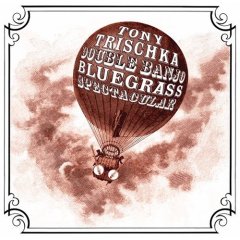
Tony Trischka
DOUBLE BANJO BLUEGRASS SPECTACULAR
Dubbed “one of the most inventive banjo players alive” by Billboard Magazine, Tony Trischka gathers friends and colleagues acquired over his 30-plus year career for his spectacular return to acoustic bluegrass.
Trischka begins his journey by going back to the beginning as he is joined by the legendary Earl Scruggs whose three-finger style is credited as a signature sound of bluegrass. They fly out of the gate with “Farewell Blues,” a 1922 jazz composition that Scruggs previously recorded in 1950. It’s fast and furious, bringing to mind Scruggs’ work on Bonnie & Clyde’s getaways. Fiddler Stuart Duncan and mandolin player Mike Compton contribute nice work as well. On “Doggy Salt” Trischka takes the chords from Flatt & Scruggs’ “Salty Dog” in reverse order, but Scruggs’ sound is unmistakable.
On his Let’s Get Small album, Steve Martin said you can’t sing a depressing song while playing the banjo and that is made evident on “Fox on the Run,” a song about heartbreak. “She took all the love that a poor boy could give her/ And left me to die like a fox on the run” should leave the listener sad, but the music is lively and peppy, defusing the mood. Former members of the Johnson Mountain Boys, who along with Sally Love form the band Seneca Rocks, join Trischka. This ensemble also performs on “Live and Let Live” from 1941, a previous hit with Bill Monroe twice, once in 1961 and again in 1978.
Martin also walks the walk when it comes to the banjo. He was inspired to write “The Crow” by Tony Ellis, a former member of Bill Monroe and the Bluegrass Boys. The song fits very well alongside Martin’s other appearance on the album, the classic “Plunkin’ Rag.” If Hollywood stops calling with bad remakes, he could very easily have a career in bluegrass.
Bela Fleck is a former pupil of Trischka and appears on three tracks. The first is Trischka’s “Twilight Kingdom,” a long, rambling tempo-changing bluegrass jam, classified as progressive bluegrass or newgrass. It presents the banjo in a different light and shows the instrument’s versatility. Members of Union Station and The Nashville Bluegrass Band back them.
The focus on the double banjo becomes more pronounced as the teacher and student continue working together. Their next track is a song they co-wrote called “Ivory Toad of Catalan,” made from pieces each of them had. A bass accompanies them. Fleck’s “Armando’s Children” is a duet, inspired by Chick Corea’s “Children’s Songs.” It fades out as if they didn’t know how to end it.
Trischka and Fleck also co-wrote “Arcadia” with help on the B part from Uncle Earl’s Abigail Washburn. It has more of a classic bluegrass sound than their other work. Alison Brown, former member of Union Station in the late ‘80s, plays banjo, and Sam Bush, founding member of The New Grass Revival, plays mandolin.
“Run Mountain” finds Trischka playing with Noam Pikelny, a former student of both Fleck and Mark Vann. He replaced Vann in Leftover Salmon after his death to cancer in 2002. Mandolin player Chris Thile from Nickel Creek and guitarist Michael Daves sing this bluegrass standard from J.E. Mainer’s Mountaineers.
“Old Cane Pole” was written and performed by Bill Emerson, a founder of the Country Gentleman, the band that pioneered progressive bluegrass, the bridge between Scruggs and Fleck.
Double Banjo Bluegrass Spectacular is a great album for bluegrass fans and a very good introduction to the curious. It is a tribute to the art form and those artists that have taken part and continue to the tradition.
0 Comments:
Post a Comment
Subscribe to Post Comments [Atom]
<< Home